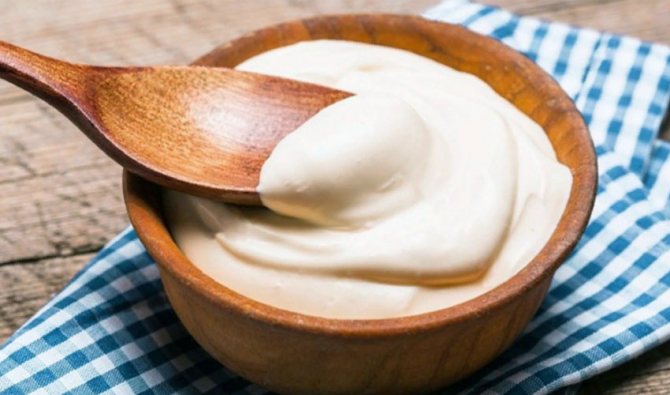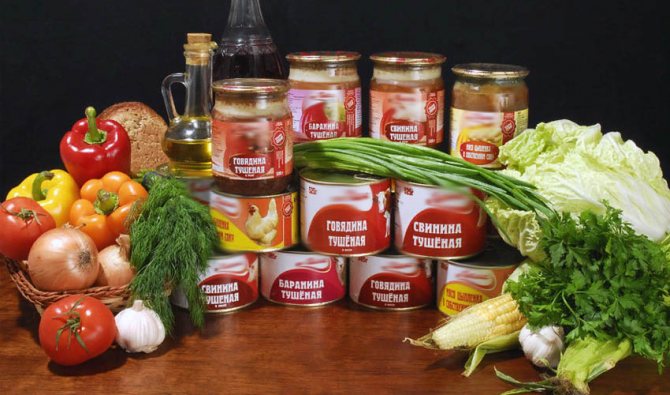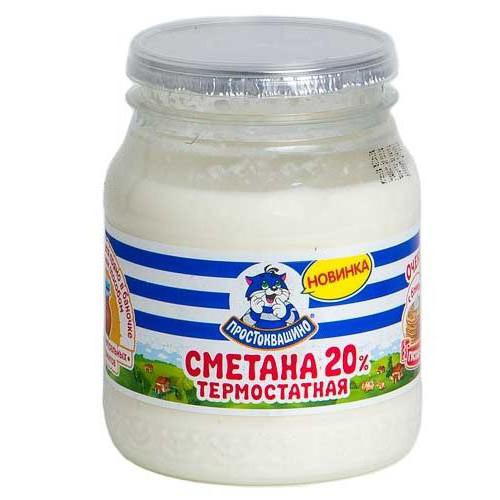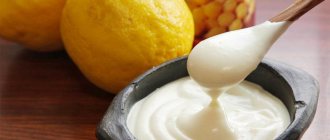Shelf life depending on packaging
In Soviet times, enterprises produced stewed meat only in tin containers, but now glass jars are common.
In the latter case, the consumer has the opportunity to familiarize himself with the product before purchasing - to assess the amount of fat and the total weight of meat. However, the shelf life of stew in a glass jar is much shorter. Of course, the presence of a sealed container prevents air and moisture from entering the product, but it cannot protect against sunlight.
Attention! The shelf life of such stew is also 3 years, but there is a possibility that during this period the product will develop an unpleasant odor. Stew, packed in a tin container, retains all its beneficial properties for a long period of time.
According to GOST standards, the shelf life of such a product is 3 years, but if the conditions are met, it can be safely consumed even after ten years
Stew, packed in a tin container, retains all its beneficial properties for a long period of time. According to GOST standards, the shelf life of such a product is 3 years, but if the conditions are met, it can be safely consumed even after ten years.
Tips for housewives
To prevent the product from spoiling prematurely and to retain its delicate taste, certain conditions for its use and storage should be observed:
- There is no need to eat from a common container, since it is unacceptable for pieces of food and bread crumbs to get into the sour cream. The spoon you use to take the sour cream should be dry, preferably scalded with boiling water.
- This fermented milk product can be stored efficiently in glass and ceramic containers. Metal and plastic containers are not suitable for this.
- The container with the product should be placed on the middle shelf of the refrigerator - the most suitable place for temperature.
- Do not remove the container with sour cream from the refrigerator even for half an hour. This reduces shelf life. If you want to drink tea with sour cream, transfer the required amount of product from the general container to the outlet.
- Do not leave a spoon in the sour cream.
- Control the “behavior” of the product. If you notice that whey has appeared, then you need to quickly consume sour cream before it spoils.
Top articles: Salted milk mushrooms
Follow these simple rules and be healthy.
How to choose sour cream? Tips for consumers in this video:
Didn't find the answer to your question? Find out how to solve exactly your problem - call right now:
Types of sour cream
According to GOST, sour cream is produced from normalized cream, reconstituted cream, recombined cream and their mixtures. In any case, sour cream is always just cream and sourdough.
The natural product has a white or slightly cream color and a glossy surface. For a product with a fat content of 10-20%, a not entirely thick, slightly viscous consistency with a slight graininess is allowed.
When purchasing, pay attention to the labeling; it must contain the word “sour cream”, without distorting the form, that is, not “sour cream” or “smetanushka”. Most often, when purchasing, we pay attention to the fat content.
Most often, when purchasing, we pay attention to the fat content.
Sour cream can be:
- Low fat: 10, 12, 14%;
- Low fat: 15, 17, 19%;
- Classic: 20, 22, 25, 28, 30, 32, 34%;
- Fat: 35, 37, 40, 42, 45, 48%;
- High fat: 50, 52, 55, 58%.
Most often we find on the shelves a product with a fat content of 10 to 25%.
Shelf life of sour cream
Sour cream is a fermented milk product whose shelf life is extremely short. It is used to prepare many dishes and is used as a dressing for soups and salads. The scope of sour cream is wide, the product differs in the percentage of fat content: the more fat, the richer and thicker it is. Type of sour cream by fat content:
- 40% - amateur;
- 30% - standard;
- 20% - dessert;
- 10% - dietary.
Shelf life of sour cream according to GOST
Sour cream prepared in accordance with GOST requirements has a shelf life of 5-10 days in sealed packaging. If the packaging shows a longer period, it means that the product is not manufactured in accordance with GOST or has additional additives. Thanks to artificial components, sour cream products can be stored from two weeks to a whole month.
Shelf life of sour cream in the refrigerator
A closed package of sour cream can also be stored in the refrigerator for 5-10 days from the date of production. If the temperature in the refrigerator is kept below zero, the shelf life of the product can increase to 30 days.
When purchasing sour cream (and any other fermented milk product), you must look at the date of manufacture.
The expiration date is usually printed next to the manufacturing date as a date, rather than the number of days of storage, which makes choosing a fermented milk product much easier.
Shelf life of sour cream in open packaging
The shelf life of sour cream in open packaging is sharply reduced to 72 hours. It will need to be stored in the refrigerator at a temperature not exceeding 6 degrees Celsius. You should not exceed the shelf life; you need to consume all the sour cream within three days.
Shelf life of homemade sour cream
Homemade sour cream is much healthier even than store-bought sour cream, which is not pasteurized and does not contain additional thickeners or artificial ingredients.
But the shelf life (and with it the storage) of such sour cream is shorter. The maximum period is 3-7 days from the moment of preparation.
It will be stored longer if you place it at a temperature below zero, but it is still recommended to use only fresh sour cream.
| Natural sour cream in the refrigerator | 5-10 days |
| Natural sour cream in open packaging | maximum 72 hours |
| Sour cream products | 14-30 days |
| Homemade sour cream | 3-7 days |
How to store sour cream
Purchased sour cream must be stored in the refrigerator. Recommended storage temperature is 3-6 degrees. For a longer shelf life, it can be kept in places with temperatures below 0.
If the sour cream has expired
It is not recommended to eat expired product: you can get poisoned. You can taste it and, if it has not spoiled completely, feed it to animals or use it in baking, but do not eat it yourself.
Shelf life of sour cream and products based on it
» » How long can sour cream be stored? Has she gone bad? The shelf life of sour cream depends on many factors, such as:
- packing date,
- cooking method,
- exposure to high temperatures and storage method.
is the result of the interaction of raw materials and a bacterial culture, which turns it into a product for daily consumption. Ready-to-eat sour cream usually has a high fat content, but there are also types with low fat content.
To obtain sour cream sauce, various spices are added to the product. So, how long can sour cream be stored? If storage is organized correctly, sour cream in special packaging can be stored according to the following periods in the refrigerator:
- regular sour cream 1-2 weeks;
- sour cream sauces 2 weeks.
- low-fat sour cream 1-2 weeks;
If the package is opened, then its shelf life for all the types listed above will be 7-10 days.
Shelf life of sour cream
Free legal advice: After the packaging has been opened, it is recommended to transfer the sour cream into a clean (preferably even sterile) jar and close it tightly with a lid.
It is also better to add sour cream to soup or salad with a clean spoon. With such proper storage and consumption, the product can be stored in the refrigerator for no more than three days.
The modern food industry, depending on the fat content, produces several types of sour cream: If this type of product is manufactured strictly in accordance with GOST, then the first two varieties after opening the package have a shelf life of 48 to 72 hours (provided that the temperature in the refrigerator is not higher than + 4 °C).
Regarding dessert and dietary sour cream, it was not possible to find information, however, we buy these two types of this product most often, and based on my own experience, I can say with confidence that they can be consumed within 5-7 days after
How to store sour cream
Sour cream is one of those products that everyone has in their refrigerator. Due to its high fat content, it is very nutritious, therefore it is used not only in cooking, but also as a healing agent.
- Whatever one may say, homemade sour cream without preservatives can be stored for no more than 3 days.
- Sour cream cannot be frozen. After defrosting it will lose its consistency.
- Do not buy sour cream with a long shelf life in the store. They probably added a whole arsenal of preservatives to it.
The shelf life of this fermented milk product is extremely short.
Country sour cream expiration date
Free legal advice: Sour cream is a fermented milk product loved by many.
It is tasty and nutritious, and is widely used in cooking. A food product made from natural ingredients has a short shelf life. How to store sour cream in different conditions, and what is its shelf life? Does tea have a shelf life or tea bags?
Find out about this from our article. Sour cream packed in non-airtight containers can be stored for no more than 3 days.
Free legal advice: A freshly manufactured product, hermetically packaged, can be stored for no more than 7 days and no more than 14 days from the date of manufacture. Shelf life of sour cream and products based on it: Store-bought.
Depending on the fat content, sour cream comes in different types: 40%, 30%, 20%, 10% fat. The shelf life of the product must be counted from the moment the manufacturing process is completed.
The manufacturer (for example, Prostokvashino) indicates it on the label or container.
Sour cream: shelf life according to GOST
0 0 Sour cream is considered a favorite product of many people.
It's tasty and healthy. Many dishes are prepared from it and also consumed as dessert. The dairy treat can be stored in the refrigerator for more than two weeks if it is hermetically sealed sour cream.
The expiration date is established by GOST. The product packaged in unsealed containers can only be consumed within 3 days.
You should consider what type of sour cream.
Shelf life of seaweed salad
In the case of seaweed salad, no rules apply, even if we are talking about a ready-made dish. The main thing is to carefully read the instructions for use, the date of manufacture of the product, and recommendations for storage temperature. It is strictly not recommended to purchase formulations with preservatives; seaweed fibers do not need them. Such components do not so much extend the shelf life of products as they neutralize useful components.

Seaweed salad that has been opened or prepared using dried ingredients must be consumed within 3 months. At the same time, it is better to store it in the refrigerator at a temperature of 3-4ºС. Before opening, it is correct to keep the canned mixture at room temperature, and preserves in the refrigerator. After opening in both cases, the seaweed dish must be consumed within two days. Storage in the freezer can extend this period to 1 month.
What factors affect shelf life?
Traditional sour cream is made from cream and sourdough. On the container, the manufacturer must indicate the composition of the product and the method of its storage . It depends on the following factors:
- The temperature should not exceed +2-6°C . With a sharp change in temperature conditions, the shelf life is reduced.
- Unopened packaging can be stored for up to 14 days . On the store counter, after two weeks from the date of production, the product is considered expired.
- The opened product must be consumed within 3 days if you store it in the refrigerator, close the lid tightly and take out a new portion with a clean spoon.
Any housewife should know that you should not take away the product with a dirty spoon . The composition should not contain bacteria that provoke the process of mold. If sour cream has acquired an unnatural smell, its texture has changed, or strange spots have appeared, you should stop using this product.

How to choose sour cream. Expert advice. Video
Of course, it is not recommended to use expired sour cream as food for yourself or your animals if you do not want to get an eating disorder. If there is no mold in it and the delay is insignificant, you can use it, for example, for baking.
In any case, the main thing is health benefits, and only fresh products bring them.
To prevent sour cream from spoiling, buy it in the amount that you can consume within the time period indicated on the package, and also pay attention to the expiration date of sour cream or sour cream product; the longer it is, the more likely it is that it will expire. technologists have “conjured” and the further they are from naturalness
What may be in yogurt
Yogurts, like fermented baked milk, can be produced by tank and thermostatic methods. Thermostatic yogurt will have curds, but regular yogurt will not.
Yogurt, just like fermented baked milk and sour cream, contains lactic acid microorganisms - at least 1x107 CFU/g. However, in yoghurts enriched with bifidobacteria, they are also present in an amount of at least 1x106 CFU/g. This yogurt is definitely healthier.
Be aware that food additives are allowed in yoghurts (food flavors, food colorings, sweeteners, flavoring agents, consistency stabilizers, thickeners, antioxidants and other chemicals). Read the label carefully.
How to choose
The classic technology for making sour cream consists of adding special lactic acid bacteria to fresh cream, resulting in a product with the following characteristics:
- homogeneous thick consistency the color of milk;
- glossy surface;
- sour taste.
When purchasing a product, you should carefully inspect the packaging and make sure that it is completely sealed and undamaged. Then you need to look at the release date, and check the shelf life, which determines the time during which the beneficial bacteria will remain normal. The shelf life of sour cream starts from the moment its production process ends.
If the shelf life of a product is not limited to 2 weeks, you should carefully study its composition. Perhaps this is not a natural product, but a surrogate with a high content of preservatives. In this case, the shelf life may be more than 30 days.
You can also understand whether this is a surrogate or not by its name. If the package says, for example, “Sour cream”, it is not a natural product. Only the name “sour cream” complies with GOST standards. All other names are a marketing ploy.
The number of fermented lactic bacteria in a quality product should not be less than 107 per 1 gram. Therefore, the packaging must contain the CFU 107 marking indicating this.
The shelf life of sour cream cannot be more than 2 weeks from the date of production. And if its surface is not glossy, but matte, the product is not natural. This effect is a consequence of the use of special food thickeners and preservatives.
If the packaging indicates a fat content of 10–20%, then a slightly viscous consistency with a slight grainy effect is acceptable.

What to do with an expired product
Many people are familiar with the situation when a purchased dairy product with a normal shelf life turned out to be spoiled. In most cases, the reason for this is a violation of the temperature regime during delivery. Or when sour cream lingers in the house longer than the expiration date indicated by the manufacturer, is it necessary to throw it away? Yes, if one of the following signs of damage is detected:
- the lid on an unopened container is swollen;
- a smell of acid or mustiness appears in the nose;
- mold stains are visible on the surface;
- When tasted on the tongue, bitterness is felt.
If the expired product has not changed in appearance, then it can be used. But only within three days after the maximum storage time, and only after heat treatment. For example, add it to pie or pancake dough, but it’s still better not to risk it.
If whey appears on the surface of the sour cream, it must be consumed one day before. The next day the product will most likely change in taste and smell.
As you can see, the shelf life of sour cream is not very long. However, if you create optimal conditions for the product, it will remain fresh for as long as possible.
How to choose
Unfortunately, not every manufacturer adheres to state standards when producing canned meat.
Therefore, when purchasing them you need to pay special attention
It is imperative that you familiarize yourself with the composition of the product and make sure that it complies with GOST 32125 - 2013. There should not be any name other than “canned meat” on the label.
The product must contain meat of animal origin. Moreover, it must belong to the agricultural group. The composition may also contain spices, salt and water.
Images and writing on the label must be clear and legible. The date of manufacture should be especially visible. It is better if it is applied with a laser or stamped on the lid.
The presence of traces of corrosion or damage to the metal container (glass jar lid) indicates improper storage of the stew. This may indicate low quality of the product or complete unsuitability for consumption.
Homemade preparations usually pose the greatest danger. Therefore, their use is possible only with full confidence in the quality of the product.
The container for the stew can only be made of glass or tin (aluminum). Other options are not allowed.

What does the packaging tell you?
The CU TR On Packaging Safety sets out the requirements for containers and materials used for transporting, storing and sealing sour cream.
Sour cream can only be stored in containers intended for fermented milk products.
The packaging must be undamaged, clean and dry .
consumer containers are allowed to be used for packaging sour cream :
- glass containers (200, 250, 500 cm3);
- cups for dairy products (200, 250, 500 cm3);
- boxes for milk and dairy products (200, 250, 500 cm3);
- packages for milk and dairy products (250, 500 cm3).
Proper packaging will not only be beautifully and stylishly decorated.
It contains all the important information , which gives the buyer a comprehensive answer to the question: what’s inside and whether it needs to be bought.
The following information is indicated on the consumer packaging:
- Product name;
- fat percentage;
- composition of the product;
- time and date of production;
- period and conditions;
- mass fraction of fat;
- number of lactic acid bacteria;
- address and name of the manufacturer;
- storage conditions;
- energy value;
- certification information;
- Net weight.
The product name must include the term " sour cream ".
If this word is inflected in some way, for example, “Smetanushka” is a sour cream product.
And the manufacturer is obliged to notify the buyer about this .
Often the corresponding note on the packaging is made in very small print.
Sour cream products have nothing in common with sour cream.
they are practically no different from it in consistency, color and taste .
In terms of their energy and beneficial qualities, they are very much inferior to real fermented milk products.
Be sure to indicate on the packaging that the sour cream was produced according to GOST, and not according to specifications.
How to save longer
Oxidation of metal containers is the main reason for the decline in the quality of canned meat. They are also negatively affected by sudden temperature changes, high humidity levels, and exposure to light (for glass containers).
To keep stewed meat at home for as long as possible, you should check the status of your supplies as often as possible. In this case, any source of corrosion is eliminated by careful sanding.
Those who decide to create large food reserves can be advised to first make sure that the cans are sealed. To do this, they are placed in a container with water, and then they observe what is happening. The appearance of air bubbles in any part of the container will indicate its leakage.
If cans of stewed meat have passed the “water test”, before storing they need to be wiped dry with a cloth, then dried further under natural conditions and only then treated with some kind of lubricant (solidol, litol 24). It helps to wrap it in parchment paper to prevent the grease from drying out.
Features of storing vegetable and fruit salads
Salads made from fresh fruits or vegetables are stored the least. Ideally, they should be consumed immediately after preparation. Despite this, there are several nuances, the observance of which will slightly extend the freshness of the components:

- You can cook only from thoroughly dried ingredients without the slightest sign of moisture. The mixing container and tools must also be completely dry and cool.
- Ingredients such as boiled eggs and various preservatives should be added to the dish last, just before serving. They need to be cut quite large.
- If there is a need to hold the finished dish for a short time, it is recommended to line its bottom with a paper towel. The finished composition also needs to be covered with a paper product and pressed lightly to the surface. Then wrap the container in film and cover with a lid.
- The dressing can also be prepared in advance, but it will have to be stored in an airtight container.
- If the time of consumption is delayed, then the salad container must be checked every three hours. We change wet towels and mix the ingredients.
- In the case of fruit, it is recommended to first place each component in a colander to allow excess juice to drain.
- Sliced apples, pears and other ingredients prone to browning should be sprinkled with citrus juice. This will not only preserve their attractive appearance, but also add a subtle aroma.
- The dish will have a nice and crisp texture if the ingredients (fruits or vegetables) are first soaked for a few minutes in ice water.

Following the recommendations for preparing fruit and vegetable salads allows you to increase their shelf life from several hours to 5-7 days without the risk of loss of taste.
How to store sour cream
The shelf life of this fermented milk product is extremely short. Any sour cream, whether homemade or purchased, should be stored in the refrigerator. At room temperature, this product can deteriorate in just a few hours.
Previously (and even now in villages) clay jugs with the same lids were used to store sour cream. To extend the life of this product, as well as preserve the smell and taste, a piece of sugar was dipped into the pot.
To enjoy this delicious product to the maximum, there are a few simple rules for use and storage:
- crumbs and other food that may end up in it along with a spoon should not be allowed to get into the container with sour cream - it must be clean and dry;
- Only a clean spoon, previously scalded with boiling water, can be immersed in a container with sour cream;
- the only materials suitable for storing sour cream are glass and ceramics; plastic and metal are not suitable for this;
- the best place in the refrigerator for sour cream is the middle shelf of the refrigerator;
- Sour cream should not be removed from the refrigerator for long; when the product is left at room temperature for a long time, it may spoil;
- You cannot leave foreign objects (spoons, for example) in a container with sour cream;
- If the whey begins to separate, then you need to use such sour cream as soon as possible, as this means that it will soon spoil.
Why does sour cream start to spoil?
The main reason is the proliferation of microorganisms. Perishable food is stored in the refrigerator in order to slow down this process. Under room conditions it occurs much more intensely. Low temperatures above zero cannot completely stop it.
Next, the microorganisms release waste products and dangerous toxins. Change in taste - only berries. If ingested, it may cause gastrointestinal upset. Some will only suffer from diarrhea. Another person will experience severe vomiting, pain in the intestines, weakness, and discoloration of the skin.
Crumbs, droplets of water, and grains of spices speed up spoilage. Therefore, we always use a clean, dry spoon. It is not advisable to leave cutlery in a jar.
How and where to properly store veal?
Meat storage Comments: 0
Veal has a high moisture content, so its shelf life is not long. This type of meat is stored for the longest time in the freezer, and in all other cases it is best to eat it as quickly as possible.
Nuances of storing veal:
- during storage, veal must be wrapped in cloth or polyethylene (this nuance is necessary to maximize moisture retention);
- if ice is used when storing veal in the refrigerator, then the meat should be wrapped in cling film or cloth and only then placed in ice;
- veal can be stored in ice water (the meat is poured with as cold a liquid as possible and placed in the refrigerator);
- It is not recommended to wash veal before storing (the liquid can cause the release of juice and cause rapid evaporation of moisture);
- You can preserve the juiciness of veal using foil (meat wrapped in foil should be stored exclusively in the refrigerator);
- When storing veal, foil can be replaced with thick paper or oilcloth;
- Under no circumstances should veal be subjected to repeated freezing;
- if the veal has not been eaten within two days, then it can be frozen (if you freeze veal after three days of storage or more, its taste and structure may be affected);
- if the surface of the veal has become sticky, then it is not recommended not only to store it, but also to eat it (such meat begins to deteriorate due to improper storage);
- sudden changes in temperature have a negative impact on the structure of the meat (veal can become rough and fibrous);
- In the refrigerator, veal can be stored in a closed container, but it must be eaten as soon as possible;
- at a temperature of +4 degrees, veal can only be stored in the refrigerator for a day, so you need to choose a place for it that is as cold as possible (the bottom shelves of the refrigerator are not suitable for this);
- minced veal cannot be stored in the refrigerator open (the workpiece must be placed in a container, plastic bag or wrapped in foil, oilcloth or cling film);
- if polyethylene is used when storing veal, then it is worth considering the fact that the meat will be stored less (polyethylene should be used only in case of emergency);
- Only high-quality veal can be stored (if the meat was purchased after incorrect storage conditions or was chosen to be of poor quality, then even the correct temperature conditions will not be able to return the veal to its original taste characteristics);
- Thawed veal can be stored for no longer than 2 days in the refrigerator.
You can extend the shelf life of veal by several days if you place it in any marinade. The most commonly used mixture is water, onion and vinegar. Any meat marinades are suitable for veal, so you can choose their compositions at your own discretion.
It is not recommended to store veal for a long time in any way. Even if this meat is frozen, it must be eaten as early as possible.
Due to increased juiciness, it quickly loses its taste properties and becomes tough, therefore, the longer the veal is stored, the more radically its structure will change.
On average, the shelf life of this type of meat in the freezer is a maximum of 10 months.
Relationship between temperature and shelf life of veal:
- from 0 to +1 degrees – 3 days;
- from +1 to +4 degrees – 1 day;
- from +1 to +2 – 2 days;
- at room temperature – maximum 8 hours.
Minced veal is stored in the refrigerator for an average of 8-9 hours. After this time, the process of changing the structure will begin. The moisture will evaporate and the minced meat will be dry.
How to store cooked and marinated meat
Marinated meat for barbecue must be stored in the refrigerator at a temperature of no more than +5 ℃. The shelf life depends on the marinade chosen. If the meat is marinated in mayonnaise or kefir, it can be kept in the refrigerator for no more than 24 hours. If you use a marinade that includes vinegar or lemon juice, the kebab can be stored for up to 3 days.
Seasonings that have an antibacterial effect can extend the shelf life of meat. Just add onion, garlic, pepper or iodized salt to the marinade
The shelf life of loose marinated kebab is 24 hours. The product, which is sold in vacuum containers, must be consumed before the expiration date indicated on the packaging.
It will not be possible to preserve marinated meat without refrigeration for a long time, especially in the heat of summer. The maximum shelf life of the product outdoors, taking into account the road, is 2 hours, and with a cooler bag - up to 6 hours. In this case, it is advisable to make a fire and fry the shish kebab as early as possible, since in its finished form it has a longer shelf life.
How long to store smoked meat
The shelf life of smoked meat depends on the cooking method. Cold smoked product can be stored in the refrigerator for 3 weeks. Hot smoked meat cannot be stored for more than 7 days.
To preserve the taste, aroma and beneficial properties of the product, wrap it in foil or parchment paper for storage. This will prevent chapping, unpleasant odor and bacterial growth.
Smoked meat can be stored in vacuum sealed packaging. However, observe the expiration dates indicated by the manufacturer.
Shelf life of dried meat
The duration of storage of dried and dry-cured meat depends on its location and packaging:
- In the refrigerator, the shelf life of the product is 6 months;
- in a cool and dry place (in sealed packaging) – 30 days;
- in the freezer - up to 12 months.
You can preserve meat for a long time at home by freezing. To preserve the taste and beneficial properties, observe the temperature regime and monitor the expiration date.
How long can I store in an open package?
A sealed container provides sour cream with protection from the influence of the external environment and inhibits the proliferation of pathogenic microorganisms, therefore, subject to storage conditions, unopened packaging can be stored until the expiration date. How long can dairy products be stored and how after opening the package, including in the refrigerator?
- At a temperature no higher than 6⁰C, sour cream in small containers is stored for no more than three days, and the dietary product “lives” even less - 48 hours.
- At room temperature, sour cream spoils within a day.
- Sour cream with stabilizers that has undergone additional heat treatment can be stored for 7 to 14 days if the recommended temperature conditions are observed.
- Bought a jar of homemade product? You have 1 to 3 days left to empty the container.
- Sour milk with preservatives and special additives “lives” the longest on the refrigerator shelf. Nothing will happen to such sour cream for a week or even two.
To increase the shelf life of sour cream, a natural preservative – nizaplin – is used.
The treat may turn sour or rancid before the last expiration date. For example, due to long-term storage in inappropriate conditions (outside the refrigerator), or careless use (if sour cream is eaten from the package or taken out with a dirty spoon).
Choice
Homemade sour cream from a farmer is considered natural. Such a product will have a creamy aroma, delicate consistency, and high fat content. But the latter property is not entirely suitable for those who are watching their figure. However, there are no additives or preservatives in our own products, which cannot be said about store-bought products.
The stores offer a large assortment. Products differ in fat content, additives and cost. Before fermentation, the cream is brought to the required fat content. Calorie content does not always indicate naturalness, that is, 12% sour cream will be suitable. Whatever the fat content, the product should not be liquid. A sign of quality is a uniform consistency. If there are grains, then the manufacturing technology was violated or the storage conditions were inappropriate.

But even if the consistency is good, this is not an indicator of naturalness. To improve it, manufacturers often add stabilizers and thickeners to their products. Stores also sell sour cream products that contain a plant base - palm oil. Nutritionists do not recommend consuming something like this.
You should take into account the prefix “bio” in the name. It indicates that sour cream is enriched with bifidobacteria and probiotics. These substances are considered beneficial for digestion. All information about the composition and storage must be on the packaging
It is important that the GOST marking is present, as this indicates naturalness and compliance with the preparation technology. If the product is manufactured according to technical specifications, then sour cream does not necessarily have a harmful composition
Probably, classic sour cream was diluted with additives, for example, bifidobacteria. Remember that it is important to choose this dairy treat carefully, as well as follow the rules for storing it.
How long can you store sour cream?
According to the legislation of the Russian Federation, sour cream is a fermented milk product produced by fermenting cream with or without the addition of dairy products using starter lactic acid microorganisms. The mass fraction of milk fat in sour cream is at least 10 percent.
Composition of natural sour cream: cream and sourdough.
The packaging of sour cream must contain the following inscription: “The number of lactic acid microorganisms is at least 1x107 CFU/g.” Moreover, this norm is indicated at the end of the shelf life. I’ll be honest: in my experience, at the end of the shelf life their quantity does not always correspond to the norm - lactic acid bacteria are very capricious and die during storage of sour cream. Therefore, at the stage of sour cream production, manufacturers add these beneficial microorganisms in large quantities - up to 1x1010 CFU/g, or even more.
If you want to please your gastrointestinal tract with beneficial microorganisms, buy freshly prepared sour cream.
After purchase, at home, pay attention to the organoleptic characteristics of sour cream. Externally, sour cream is a homogeneous thick mass with a glossy surface
With a mass fraction of fat from 10% to 20%, an insufficiently thick, slightly viscous consistency with a slight graininess is allowed. If you feel mealy, this may indicate that starch was added to the sour cream to obtain the desired consistency.
How to determine whether starch was added to sour cream and other lactic acid products? Here is the simplest and most well-known method. Add a drop of iodine to a tablespoon of sour cream and stir. If the sour cream turns blue, then the product contains starch; if it turns yellowish, then the product is natural. This home method for identifying starch can be applied to all dairy and fermented milk products.
The color of high-quality sour cream is white with a creamy tint, uniform throughout the mass, and not yellow at all. Even sour cream with a mass fraction of fat of 40% or more should not have a yellow color - otherwise it contains either dyes or vegetable fats.
Although, in accordance with GOST, the shelf life of sour cream from the end of the technological process is set by the manufacturer, I personally believe that it is optimal to store sour cream for up to 14 days in the refrigerator. Do not forget about the shelf life after opening the package.
Avoid sour cream whose packaging is deformed or its integrity is compromised - it is teeming with microbes. Buy sour cream in those chains where temperature storage conditions are observed.
GOST will tell you what's inside the package
The basic requirements for production technology, packaging, storage, transportation and composition of raw materials are enshrined in law in the interstate standard GOST 31452–2012 .
GOST R 52092–2003 - number of sour cream produced in Russia.
If these numbers are on the container, you can safely buy .
They say that the package contains real sour cream.
It is produced without the addition of micro- and macroelements, vitamins , prebiotic substances and probiotic cultures.
According to GOST, sour cream is created from cream by fermentation and must have a fat content of at least 10%.
Signs of spoilage of a dairy product
If the expiration date has expired, sour cream can be used for another 3 days to make dough. The effect of high temperature helps to neutralize pathogenic bacteria.
The following manifestations indicate complete deterioration of the product:
- intense sour odor;
- heterogeneous consistency;
- slimy texture;
- bitterness in taste;
- yellowish or gray spots;
- musty smell.
Even if one sign is identified, you will have to stop consuming sour cream. Otherwise, there is a risk of severe deterioration in health. Storing sour cream has a number of features. By strictly following the recommendations of specialists, it is possible to avoid unwanted health consequences.
Share link:
How to tell if the stew has gone bad
Eating an expired product or stewed meat with damaged packaging can be deadly, since in both of these cases poisons accumulate in the jar.
Despite the fact that most canned food is suitable for consumption even after the expiration date indicated by the manufacturer on the packaging, if possible, it is better to avoid this. During storage, store sellers or the consumer himself could violate some standards, which could lead to damage to the product.
When purchasing stewed meat, you should pay attention to the tightness and integrity of the container. Even if there is one spot of corrosion, you should refuse the purchase, as this may indicate that moisture has entered the product, which leads to spoilage of the product
Watch a video about how long you can store stewed meat
Rules for determining delay
The date stamped on the package may not mean anything, so the consumer must know how to determine the degree of freshness of the product.
Signs indicating that sour cream has lost its freshness include:
- The appearance of an unpleasant odor;
- Change in product color;
- The appearance of mold.
Any of the above signs indicates that the use of such a product is strictly prohibited.
The expiration date specifies the length of time during which a person can consume a product. After this time, eating sour cream is not recommended. This information must be reflected by the manufacturer on the packaging.
Shelf life of homemade sour cream
Homemade sour cream is much healthier even than store-bought sour cream, which is not pasteurized and does not contain additional thickeners or artificial ingredients.
But the shelf life (and with it the storage) of such sour cream is shorter.
The maximum period is 3-7 days from the moment of preparation. It will be stored longer if you place it at a temperature below zero, but it is still recommended to use only fresh sour cream. Shelf life of sour cream
| Natural sour cream in the refrigerator | 5-10 days |
| Natural sour cream in open packaging | maximum 72 hours |
| Sour cream products | 14-30 days |
| Homemade sour cream | 3-7 days |
Cold storage
Whatever the expiration date of sour cream, it must be put in the refrigerator. It is stored at temperatures from +6 to +8 degrees. If it is lower, the shelf life increases. Storability is affected by whether preservatives were used.

The product in closed packaging is stored at temperatures from 0 to +6 degrees. What is the shelf life of sour cream in the refrigerator? It reaches 10 days. There is no need to freeze dairy treats, since the beneficial taste properties are lost and the consistency is disrupted. What is the shelf life of sour cream after opening the package? The product must be poured into a glass container, covered with film, and secured with an elastic band. You can use a lid. It should be consumed within 3 days.
Storage rules and periods
To preserve sour cream, you must follow a number of recommendations. This allows you to achieve excellent results.
In a refrigerator
To store sour cream for a long time, it should be kept in the refrigerator. It is permissible to place a closed container on the middle shelf. It is placed away from the back wall. It is recommended to store opened sour cream differently:
- take a dry and clean jar;
- move the sour cream from a glass or bag - this is done with a clean and dry spoon;
- Close the jar with a washed lid and place it in the refrigerator for storage.
If you put the product in a glass container, it can be stored for 2-3 days. Usually the packaging indicates how long the sour cream can be stored after opening the container. It is usually recommended to eat it a day before.
Without refrigerator
At +8-10 degrees, the sour cream will turn sour after 5-6 hours. In an open container it will spoil within 1 hour. The warmer the room, the faster the product will sour.

To increase the shelf life to 1 day, you can do the following:
- Transfer the product to a dry and clean glass or ceramic jar.
- Fill the pan with cool water.
- Lower the container with the fermented milk product and cover it with a damp cloth. It should be natural. The edge of the material must be lowered into water.
- Place the pan in a cool place. It should not be exposed to sunlight.
If it is possible to move the container to the cellar, the shelf life of sour cream will increase. In this way it will be possible to maintain its freshness for up to 2 days.
Freezing
If necessary, sour cream can be frozen for up to 3 months. At low temperatures the product does not deteriorate. However, it is worth considering that its taste deteriorates and its consistency becomes liquid. Sour cream that was in the freezer can be used for baking. You can also use it to make sauces and ice cream. Before freezing, experts recommend beating this product well. Thanks to this, it will be possible to achieve uniform distribution of moisture and obtain a dense consistency.
How to store at home: conditions, place, container and timing
Sour cream, like cottage cheese, milk, kefir, fermented baked milk, is a perishable dairy product. The shelf life of sour cream depends not only on the production technology, but also on the type of packaging.
For packaging and subsequent transportation, special containers are used:
- glass bottles;
- plastic glasses;
- high-strength polyethylene bags;
- cardboard boxes.

Modern types of sour cream packaging
Products purchased in a store must be stored in the refrigerator. The storage temperature for sour cream is from 3 to 6 degrees.
Soft packaging made of polyethylene is lightweight and low cost. However, it does not imply a long shelf life. If you bought sour cream in a fin-pack package and opened it, then before putting it in the refrigerator, it is better to pour it into a clean glass jar. If the package has not been opened, then it is better not to pour its contents.
Semi-rigid packaging in the form of cups made from special thermoplastics has many advantages:
- shock resistant;
- retain shape;
- ease of use is ensured by the presence of a cap or plate made of thin foil covering the package;
- The shelf life increases by 2-3 times both before and after opening.
Tetra-pack, pure-pack and doy-pack packaging are in great demand today. This is explained by the strength of the material and its high environmental properties. In lightweight, compact, light-proof polymer boxes, the product is completely protected from light, which facilitates long-term storage.
How to store store-bought sour cream in closed and open packaging
How long sour cream can be stored in the refrigerator depends on the tightness of the packaging and temperature:
- If it is about 0 °C, then the unopened product can be stored for up to 30 days. Therefore, you need to pay attention to the date of manufacture and the expiration date marked next to it. It is indicated not by the number of days, but by a specific date.
- It is important to know how long opened sour cream is stored. A product stored unopened is considered fit for consumption within 3 days. The temperature in the refrigerator should not exceed 6 degrees.
Storing loose and homemade sour cream
Country sour cream, which does not contain preservatives and synthetic thickeners and does not undergo a pasteurization process, is undoubtedly more useful. On the other hand, it can be stored for less time than store-bought. At a temperature of 3 degrees, the shelf life is 10 days.
Do you know that…
Store-bought sour cream should be sold in retail premises equipped with special refrigeration equipment. Such a product should be sold within 2-3 hours.
Can it be frozen?
Consumers are often interested in the question of whether it is possible to freeze sour cream for longer storage. If necessary, it can be stored in the freezer for 3 months. Thanks to the low temperature, the product does not spoil. But it should be taken into account that its taste deteriorates, and its consistency becomes more liquid.

Frozen sour cream can be used, for example, for baking or making sauces and ice cream
Note to the hostess
Experts advise whisking the sour cream thoroughly before freezing. This will help distribute the moisture evenly and create a denser mass.
Can it be stored without refrigeration?
It's hard to believe that in ancient times people did without refrigerators. At the same time, even in the warm summer season they managed to keep butter, fish, and milk fresh.
- Milk, sour cream or other fermented milk products were placed in a glass jar or clay jug.
- They were placed in a container of cold water, which was changed periodically.
- The top was covered with a wet piece of cotton cloth, the ends of which hung into the water.
Using this simple method, the temperature is maintained cool and the product remains fresh. However, the shelf life is no more than a day.











